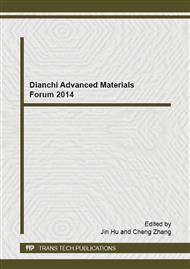[1]
R.S. Levine, The action of fluoride in caries prevention, Br. Dent. J. 140 (1976)9-14.
Google Scholar
[2]
A. Halse, E. Hals, Electron probe microanalysis of recurrent carious lesions adjacent to silicate fillings, Calcif. Tissue Res. 21(1976)183-193.
DOI: 10.1007/bf02547395
Google Scholar
[3]
A. Veira, I. De Souza, A. Modesto, Fluoride uptake and release by composites and glass ionomers in a high caries challenge situation. Am. J. Dent. 12(1999)14-18.
Google Scholar
[4]
R.C. Randall, N.H. Wilson, Glass-ionomer restoratives: a systematic review of a recurrent caries treatment effect, J. Dent. Res. 78(1999)628-37.
DOI: 10.1177/00220345990780020101
Google Scholar
[5]
A.M. Hegarty, G.J. Pearson. Erosion and compressive strength of hybrid glass ionomer cements when light activated or chemically, Biomaterials 14(1993) 349-352.
DOI: 10.1016/0142-9612(93)90053-5
Google Scholar
[6]
R.G. Craig, W.J. O'Brien J.M. Powers, Dental materials-properties and manipulation. fifth ed., St. Louis, CV Mosby, (1992).
Google Scholar
[7]
J. Arends, Fluoride-releasing from a composite resin, Quint. Int. 19(1988)513-4.
Google Scholar
[8]
X. Xu, Compressive strength, fluoride release and recharge of fluoride-releasing materials, Biomaterials 24(2003)2451-61.
DOI: 10.1016/s0142-9612(02)00638-5
Google Scholar
[9]
I.A. Mjor, Placement and replacement of restorations, Oper. Dent. 6(1981)49-54.
Google Scholar
[10]
X.Y. Zhao, Y.J. Gui, S.B. Li, Fluoride release and recharge ability of a novel fluoride release composite resin, Advanced Materials Research 833 (2014) 355-359.
DOI: 10.4028/www.scientific.net/amr.833.355
Google Scholar
[11]
P. Dionysopoulos, N. Kotsanos, Y. Papadigiannis, Lesions in vitro associated with a Fl-containing amalgam and a stannous fluoride solution, Oper. Dent. 15(1990)178-185.
Google Scholar
[12]
E.J. Swift, In vitro caries-inhibitory properties of a silver cement, J. Dent. Res. 68(1989) 1088- 1093.
DOI: 10.1177/00220345890680060601
Google Scholar
[13]
K.J. Donly, Enamel and dentin demineralization inhibition of fluoridereleasing materials, Am.J. Dent. 7(1994)275-278.
Google Scholar
[14]
K. Kawai, D. Tantbirojn, A.S. Kamalawat, In vitro enamel and cementum fluoride uptake from three fluoride-containing composites, Caries Res. 32(1998)463-469.
DOI: 10.1159/000016488
Google Scholar
[15]
S.D. Yaman, O. Er, M. Yetmez, In vitro inhibition of caries-like lesions with fluoride-releasing materials, J. Oral Sci. 46(2004)45-50.
DOI: 10.2334/josnusd.46.45
Google Scholar
[16]
D. Peng, R.J. Smales, In vitro fluoride release from aesthetic restorative materials following recharging with APF gel, Aust. Dent. J. 45(2000)198-203.
DOI: 10.1111/j.1834-7819.2000.tb00557.x
Google Scholar
[17]
S. Hatibovic-Kofman, G. Koch, Fluoride release from glass ionomer cement in vivo and in vitro, Swed. Dent. J. 15(1991) 253-258.
Google Scholar
[18]
M. Svanberg, Class II amalgam restorations, glass ionomer tunnel restorations, and caries development on adjacent tooth surfaces: a 3 year clinical study, Caries Res. 26(1992) 315-318.
DOI: 10.1159/000261459
Google Scholar
[19]
R.M. Wilson, K.J. Donly. Demineralization around orthodontic brackets bonded with resin-modified glass ionomer cement and fluoride-releasing resin composite, Pediatr. Dent. 23(2001) 255-259.
Google Scholar
[20]
M.J. Tyas. Clinical evaluation of a polyacid-modified resin composite (compomer), Oper. Dent. 23 (1998) 77-80.
Google Scholar


